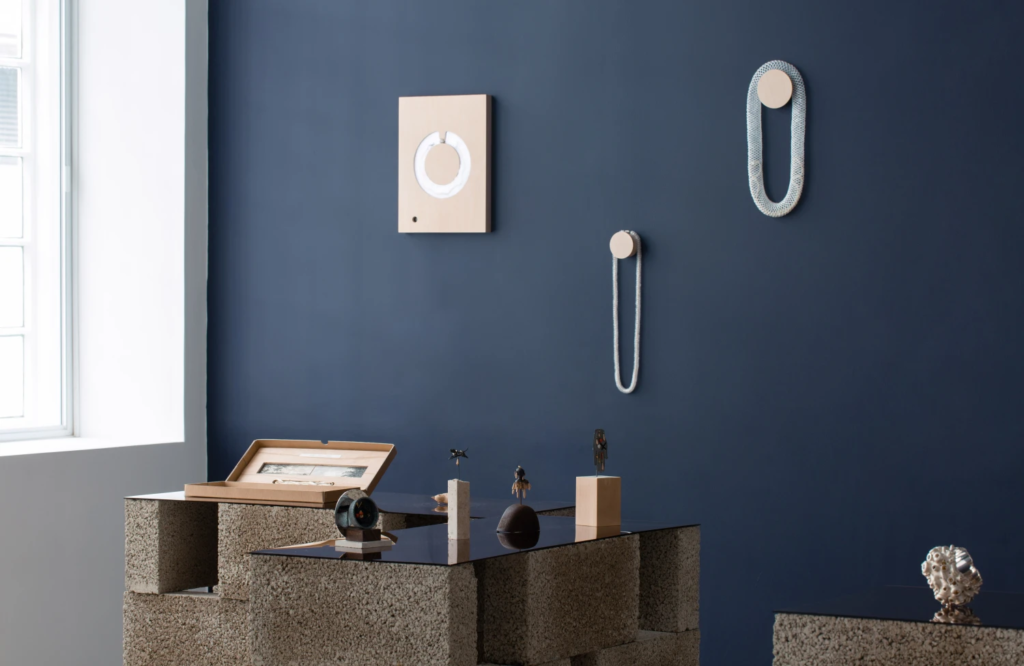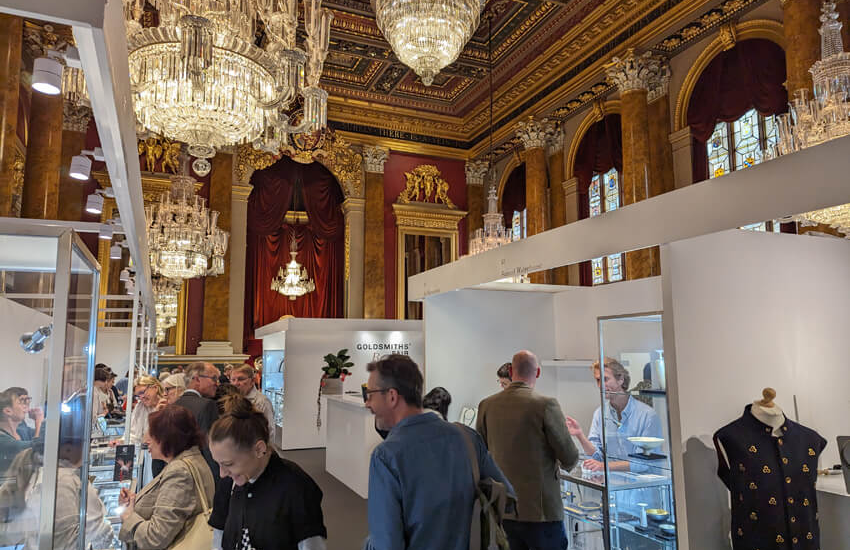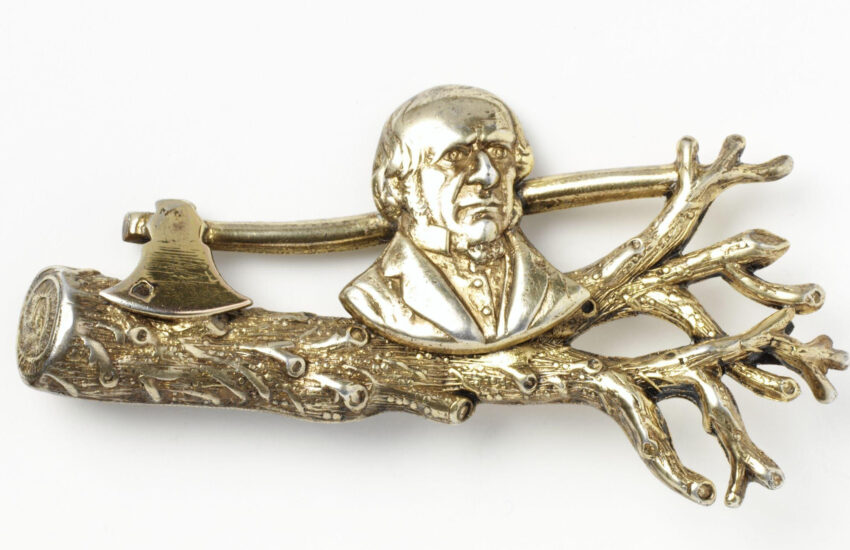Exhibition Review: Memories are made of this
What does it mean to remember? Jewellery is often an act of memory, both personal and public. Jewels are made in a moment in time and hold that memory but, sometimes they serve to record another moment. A wedding ring records the exchange of vows, a mourning ring can encapsulate a whole relationship. Each object stands for a feeling or a memory, a physical incarnation of a moment of joy, grief or history.
In the exhibition ‘Memories are made of this’ at the Sarah Myerscough Gallery in London (22 November 2023 to 27 January 2024), a group of 15 jewellers were asked to grapple with this question: What are memories made of? How can memory be represented or interpreted through a three-dimensional piece of jewellery? Each of them rose to the challenge in a different and interesting way, using jewellery to examine deeply emotive personal memories as well as broader interrogations of the nature of memory itself. The exhibition, curated by Corinne Julius, not only looked at jewellery through the lens of memory but included a vast variety of materials, from precious materials and gemstones to found objects.

Memories of public events
Although most of the participants looked at memory from a personal angle, a few jewellers considered more public events. Not every message may be openly spoken, sometimes from a desire for discretion between lovers but sometimes because of the danger of dissenting from the regime in power. Historically, political and protest jewels often held coded messages – jewels worn by supporters of the exiled Stuart kings of Britain in the seventeenth and eighteenth century used a secret language of symbolism, understood by those who held the same views but deniable to hostile authorities. During the second World War, people in occupied countries also used jewellery as a sign of protest, whether it was jewels in patriotic colours, coins with the head of the exiled Dutch queen Wilhelmina set into bracelets and necklaces or gem-set caged bird brooches displayed in the windows of Cartier’s Paris branch.
Elaheh Naghi Ganji is a recent graduate of the Royal College of Art and her work is based on recent events in her native Iran. In Kian, a series of rainbow coloured rings in different sizes are suspended from a hoop to form a necklace. A ring sizer placed near them is engraved with Farsi letters, when the rings are placed in turn on the ring sizer, a message can be spelled out, known only to the owner of the jewel.
Kathie Murphy’s work also responds to global events and contemporary preoccupations. In Anthropocene? she enclosed charcoal in a layer of resin, to reflect on the destruction of the natural world in the human dominated Anthropocene age and the overwhelming production of plastics. Millisecond Reflection comments on the sometimes negative effects of our preoccupation with image and social media. The sections of her necklace are made up of beads in which palladium leaf is set under resin, creating a mirror-like surface. The box supporting the work is a photograph box, marking the way in which we often feel scrutinised by the public gaze.
How is memory formed?
Memory is intensely mutable. Anna Gordon and Lin Cheung both address the way in which memories are formed. Lin Cheung’s beautifully simple jewels are carved from cacholong, a milky white variety of opal, and set on blocks of marble impressed with the shape of the jewel. The plain surface of the jewels nevertheless holds the memory of the hand carving them, while the negative space of the ring or bangle is held in the block of marble. Each piece is almost the platonic ideal of the form, a blank surface on which we can project our own thoughts.
Anna Gordon’s pairs of brooches are set in egg-shaped gesso frames. They were inspired by her experience as a twin. She shared her childhood experiences with her brother but found that they each remembered them very differently. The oval brooches are inspired by lockets and each pair use the same visual language, expressed differently. In Shared Memory III, tubes of oxidised silver and yellow gold are soldered horizontally to the surface in one brooch and presented end on in its pair, demonstrating that a memory or a jewel can be made from the same basic materials but the final product becomes quite variable.
Silvia Weidenbach’s A Touch of Razzmatazz bangle is perhaps the simplest comment on memory, a joyful bangle set with citrine and moondust made as an embodiment of the joy to be found in life.
The jewellery of loss and love
Jewellery has often been connected to death and loss. Some of the earliest surviving jewels were placed in tombs, to accompany the dead on their eternal journey. From the seventeenth to the early twentieth centuries, memorial rings, brooches and lockets were distributed to the friends and families of the deceased. These jewels were engraved with the name and life dates of the person, sometimes set with images or locks of hair, a way to keep a physical memento of a lost person. Many of the jewellers in the exhibition used their work as a way to reflect on their own lives and losses.
One of the hardest losses to bear is that of a child and Maria Hanson’s intensely moving pieces Full; Loss, Life and Love and Empty are a response to the stillbirth of her first son, Thomas. Full and Empty are oxidised silver pendants, suspended from chains set with pearls and coral. The surface of Full is etched with a pattern like the map of a world or an ultrasound scan, while Empty shows a plain polished surface. Each pendant shows the change from the fullness and hope of pregnancy to the empty arms and womb which follow the loss of the much wished for child. Loss, Life and Love is a long chain made up of three rows of handcrafted silver rings, relieved only by three small dots of gold. The chain, though quiet in design, is full of symbolism. 333 rows of three links add up to 999 links. With the three gold dots, representing each of Hanson’s children, the total comes to 1002, the number of weeks from the death of Thomas to the date on which she agreed to take part in the exhibition. The necklace became a way to hold Thomas as part of her family, uniting all her children in a piece of memorial jewellery.
Jessica Turrell’s subtle plaster and enamel jewels also examine loss and absence. The Presence of Absence Series is a group of five hanging necklaces set with enamelled panels, like a child’s drawing of a house, enclosing a hidden message written on paper tied into the panels. Remains, Absence and Traces are set into blocks which include empty cavities and which remember the loss of her adult son.
Grandparents and children
Alice Biolo is a recent graduate of the Glasgow School of Art. Her brooches also address loss, in her case, that of her grandfather. The outer surface of each brooch is plain and undecorated, keeping the memories inside as personal as the wearer desires. Memories can be joyful as well as painful and Green Tomatoes marks a funny moment in her grandfather’s life. The back of the brooch is set with red and green cubic zirconias, recording the year in which her colour-blind grandfather planted green tomatoes, to the great annoyance of her grandmother.
Jonathan Boyd’s work combines text, photographs of his childhood home, his grandfather’s watch and a bus seat covered in the fabric used on his childhood bus route to examine memory and family. The installation …this is not a house… takes photographs of his childhood home and his thoughts on it and transforms them into a book of images and text, and a brooch formed from typeset letters twisted into a knot. Images of the brooch taken from different angles were printed onto ovals of card and strung into a necklace, distorting the memory through yet another iteration. Relationships with grandparents can often be very close and Boyd also remembers his grandfather through his work. …it matters what knots knot knot ..(or) …why are you wearing my granda’s watch uses his grandfather’s railway service timex watch to look at the making and unravelling of memory. The lower strap of the watch has been transformed into an unravelling series of golden wires, perhaps showing the loosening of memory associated with age or looked at differently, the roots of a family tree combining the generations.
Love, actually?
Rather surprisingly, only one jeweller found inspiration in romantic jewellery. Miles Robinson, a recent graduate of Central St Martin’s took his idea from the phrases found on posy rings of the seventeenth and eighteenth centuries. Taking what might be one of the least romantic materials imaginable, he cut out squares of letters from the base of brown beer bottles and set them into a steel grid to make brooches with posy like messages. Cleverly displayed on the back of a tweed coat, they make jewels which are rich in meaning.
Jewellery and the child
The most intense memories are often formed in childhood. Zoe Arnold’s jewels were inspired by her youth and current experience of parenthood. Found objects combine to make poetic miniature sculptures. In Wren, she turned a carved limewood bird into a brooch, inspired by learning that the word ‘wren’ had been dropped from a children’s dictionary, as not relevant to a modern child. Hello is a little lead dog, referring to her childhood longing for a pet, although ironically, made from a material now banned from toys. Nest is a reflection on motherhood, a circular zinc frame enclosing a nest of oxidised wire and small coral fruit, a safe home in which to nurture a child.
Found materials also form the basis of Romilly Saumarez Smith’s designs. In The Green Grass of Home a gold ring is set with a spray of green horsehair and balanced on a tiny tombstone. The title is taken from Tom Jones’ song in which the homesick narrator finally returns to the green grass of his home, but in a coffin.
Mark Nuell was almost bound to become a jeweller. When his parents emigrated to Australia, they moved to the outback and took up small-scale sapphire mining. His childhood was spent collecting fragments of sapphire and playing among the mines. The three pieces he made for the show were inspired by this unusual early life. Box of Treasure is a brooch shaped like the tobacco tin which held his childhood finds and is set with colourful Australian sapphires. Bright Lights, Big City is an exuberant pair of earrings inspired by the excitement of moving to the city as a young man and the Palette of Colours ring is a tribute to his mother’s embrace of outback life.
Reflecting on the lives of women
Maria Militsi and Caroline Broadhead also looked at the memory and experiences of women in the twentieth century. Militsi’s work was inspired by her memories of her mother and aunt in post-war Greece. Militsi’s mother was a talented artist who, limited by motherhood and marriage, turned her attention to painting flowers. A broken statue of a putto has been crowned with a brooch made of carved flowers as a reflection of her mother’s often anonymous work. Her aunt’s life as an artist is represented by a scraper and stool on which tiny splashes of gold turn into little pins which can be removed and worn. Broadhead’s examination of memory is described in the catalogue as ‘sometimes buried for a long time, sometimes hard to retrieve, or sometimes making itself felt at unexpected moments’. Three necklaces entitled Memory I, Memory II and Memory III are formed of vintage pearl necklaces, a jewel which was almost a cliché of twentieth century respectability and femininity. Her work deconstructs and reimagines the pearl necklace, by setting it in a cage of glass beads or against a lightbox, making it suddenly strange and new.
Displaying memory
The exhibition is held within a single room, with the works on open display. Hung from the walls or set on mirrored surfaces balanced on concrete breezeblocks, they can be experienced close up and intimately. Each work stands in its own right but is enriched by the back story and thought placed in them, making a strong statement of what memories can be made of. Memories are made of this… is an exhibition which provokes thought and emotion and which shows the infinite variety of expression made possible by jewellery.
The catalogue of the exhibition can be found here.
Other exhibition reviews: The art of movement – Van Cleef and Arpels, Tiffany in London and the Queen’s Jewels platinum jubilee exhibition.


